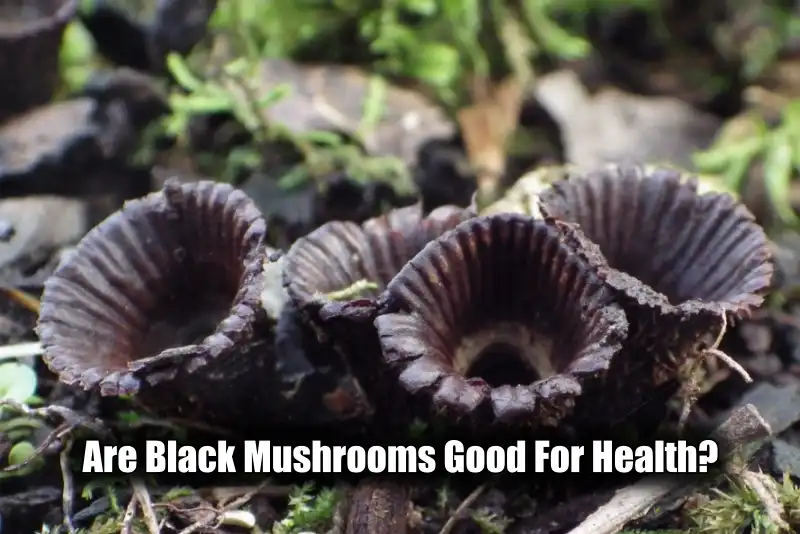A mushroom is the fleshy, spore-bearing fruiting body of a fungus. At first, the mushroom was discovered as a toadstool, which meant where toads sit and hence was considered poisonous for humans. Later, the discovery of button mushrooms led to the name mushroom, which was edible.
What Are Black Mushrooms?
If you were to observe nature closely, you would have noticed that some colors, like green, orange, and purple, are common in nature, as the substances responsible for their color, like carotene, chlorophyll, and anthocyanin, are common in nature. But black is rare, though not as rare as we think.
So what is black? Black is when all the light that falls on the body is absorbed by it. Though in general, black is regarded as something bad or evil, it is also seen as something powerful and elegant. Though initially associated with death or mourning, it was later worn by English romantic poets. The color is used in printing books, as the black color is most contrasting.
Why do organisms adapt to black? It may be to camouflage in darkness, as a mechanism to prevent heat loss, or to convey some warning signs to its predators; it depends on the organism and the environment in which it lives.
Organisms with a black color are undeniably attractive, so what if the mushrooms are black?
So what are black mushrooms? They are nothing but mushrooms with black color. They are mostly seen in around North America.
Black mushrooms have always been a topic of interest to many maybe due to their color or mysteriousness, but they seem to lie under and not give out much information. The reason why the mushrooms are black in color is unknown but it may be a camouflage mechanism or to seem intriguing like many other organisms that wear dark forms.
Interesting right? So how attractive do you think they can be? Have you heard of black mushrooms? Did you know they exist? Can they be eaten? Let’s learn about all this in this article.
Names of Some Black Mushrooms
1. Western Black Elfin Saddle
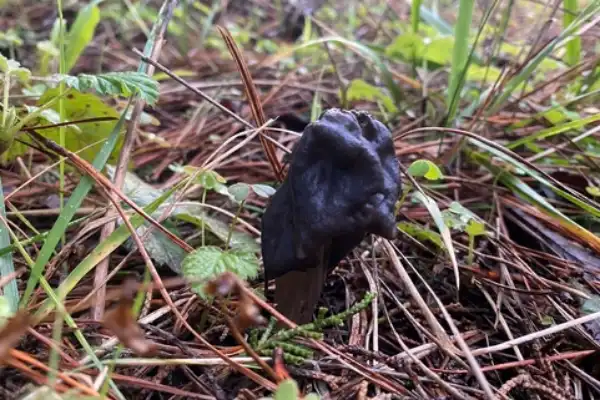
- Scientific Name: Helvella vespertina
- Toxicity: Neither edible nor poisonous
These black mushrooms are found in Western North American conifers. The cap is black with white stripes. And it is rare to see a white cap and blue stripe. The cap of these mushrooms has a diameter of 6–8 cm. These black caps are only suggested for eating. They are recommended to eat only after cooking.
However, these black mushrooms are not edible in some regions since they cause digestion issues.
2. Devil’s Urn

- Scientific Name: Urnala craterium
- Toxicity: Unclear
This black mushroom is very mysterious. Its poisonous status is unclear, and the fruiting bodies of these mushrooms are not considered fungi. It grows on decaying oak trees, and dead beaches and also inhibits other fungus growth. It is a parasite on oak trees. It can be widely seen in North America, Europe, and Asia.
These black mushrooms are 1mm long and 3-4 cm wide.
3. Old Man of the Woods
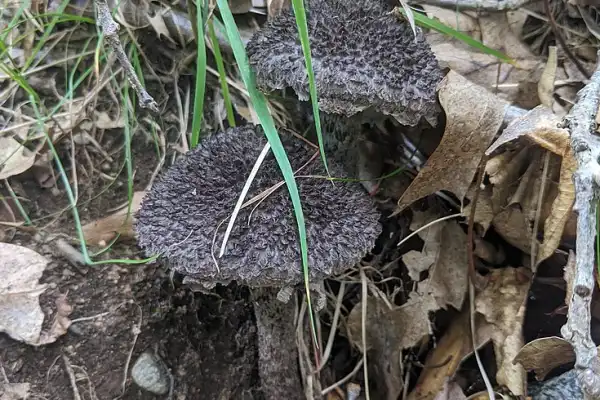
- Scientific Name: Strobilomyces strobilaceus
- Toxicity: Not poisonous
This black mushroom is native to Europe and North America. The cap is convex and 4–10 cm wide. These mushrooms are as tall as they are wide. If you love to eat mushrooms, then this is the best mushroom. The young specimens of these black mushrooms are edible, and the taste is considered to be great.
These black mushrooms are black, and the cap is covered with flecks.
4. Black Bulgar
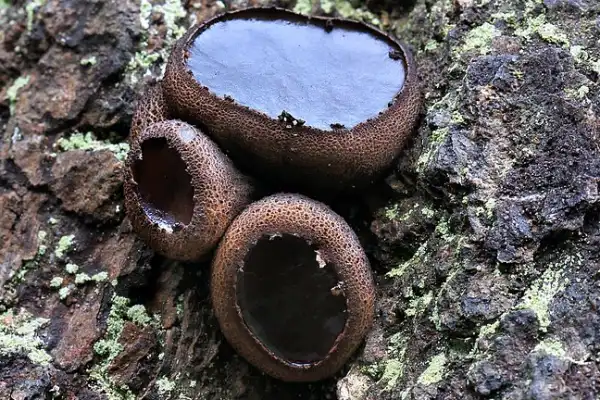
- Scientific Name: Bulagria inquinens
- Toxicity: Unclear but inedible
Depending on the dry weather, the texture of these black mushrooms changes to a leathery or elastic structure. These black mushrooms have the tendency to grow in clusters. This black mushroom has a diameter of 0.5 to 4 cm. These mushrooms grow on the decaying wood of oak and hornbeam trees.
These mushrooms grow in Europe. These black mushrooms are also called poor man’s licorice or black jelly drops.
5. Black Elfin Saddle
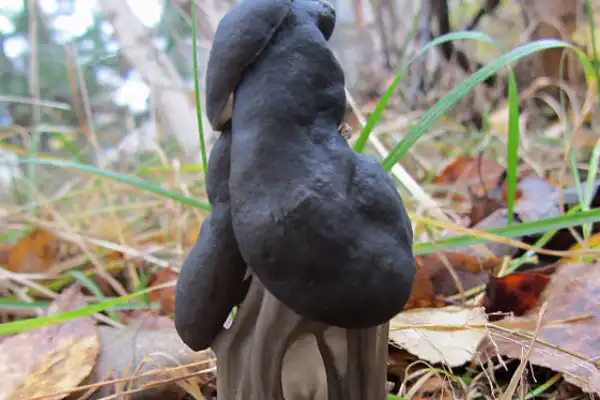
- Scientific Name: Helvella dryophila
- Toxicity: Not poisonous
These black mushrooms love oak trees and grow on decaying oak wood. These mushrooms do not have a distinguishable smell or taste to them, though they are edible partly only.
It has a white cone-shaped stipe and a black wrinkled cap whose diameter is around 5cm. These black mushrooms grow in North America.
6. Dune Stinkhorn
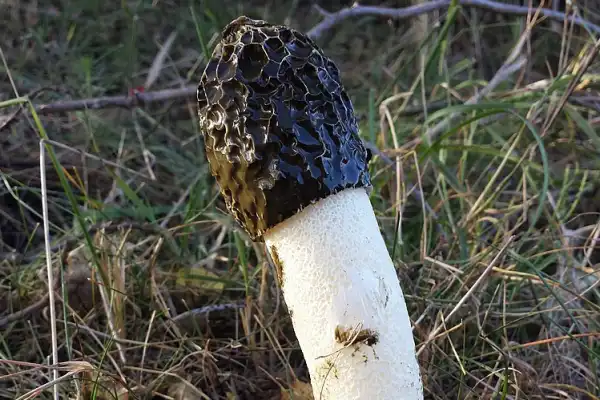
- Scientific Name: Phallus Hadriani
- Toxicity: not poisonous
Yes, you guessed it right! These black mushrooms are known as stinkhorns because they stink. However, the odor may also be pleasant, depending on the season. The odor produced by these black mushrooms is to attract insects or bugs and in order to spread their spores.
By spreading their spores like this, they are known to be everywhere in the world, especially in tropical forests. These porous mushrooms are known to be the fastest-growing mushrooms in the world. However, technically, it is not growing. It uses cellular origami by absorbing water.
7. Star capped coprinus
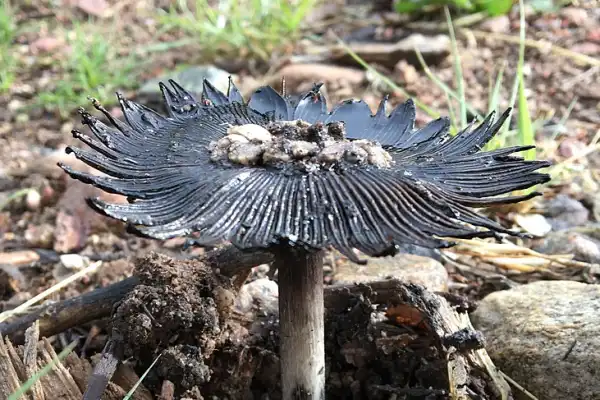
- Scientific Name: Coprinus calyptratus
- Toxicity: Unclear but not edible
The photo above depicts the early stage of this black mushroom, but as it grows, the cap itself flattens out. The black gills of this mushroom can be seen once the cap completely flattens out. These black mushrooms are grown in grasslands and dunes like Western North America.
This black mushroom’s poisonous status is unknown, but it is definitely not edible.
8. Hairy Earthtongue
- Scientific Name: Trichoglossum hirsutum
- Toxicity: Unclear
Exactly! This mushroom is tongue-shaped and looks like it has come out of the heart. Hence, the name earthtongue.
These black mushrooms do not have a typical cap. These grow on decaying pine trees. It also grows on sandy soil and beaches on the Western Coast. The DNA evidence of this black mushroom suggests that they are species-similar.
These black mushrooms grow in clusters. In which tens of mushrooms grow at varying heights. But sadly, these black mushrooms are declining due to human agricultural practices.
9. Sooty Cup
- Scientific Name: Dissingia leucomelaena
- Toxicity: poisonous and not edible
The cap of this black mushroom is 3.5 cm, and the stem is white. The cap of this mushroom will be seen to have dirt on it since it grows so closely to the ground.
The habitat of this mushroom is coniferous trees in North America, but it is now expanding worldwide. This mushroom is not edible since it contains a carcinogen known as gyromitrin.
10. Dewdrop Mottlegill
- Scientific Name: Panaeolus acuminatus
- Toxicity: Poisonous
One interesting fact about this black mushroom is that it contains small amounts of serotonin. Its cap is less than 4cm. This black mushroom grows on dung and grass. This grass is widely grown in North America and Europe.
These mushrooms grow in decaying woodlands and always grow in groups. These black mushrooms are poisonous, and one might feel sick after a few bites.
11. Blackedged Shield
- Scientific Name: Pluteus atromarginatus
- Toxicity: Edible
This black mushroom is a true artist’s work. With the black-edged gills, they are a true masterpiece. Though the black mushroom is edible it is not recommended to eat as they are very rare. They are originated in Britain and Ireland. The blackedge is seen emerging from the gap between two old railway sleepers.
The black mushroom is 4-7cm wide and 5-12cm long. The mushroom being fleshy, beautiful, and with no distinct taste is tempting enough to eat, but as a living being it is important to save other beings.
12. Fluted Black Elfin Saddle
- Scientific Name: Helvella Lacunosa
- Toxicity: Initially, it was considered edible, but its genus members are found to have toxic substances (monomethylhydrazine), which, when consumed raw, can cause gastrointestinal symptoms.
The European mushroom can be easily identified by its irregular-shaped gray cap and fluted stem. The stems are normally not consumed. These are also seen in eastern North America.
The black mushroom is associated with conifers and is usually mistaken for one that appears in western North America and is associated with oak.
The black mushroom grows up to 2–4 cm wide and 4–10 cm tall. They are usually found on burnt woodland grounds. The black mushrooms are recommended to be eaten only after they have been cooked. These are low-quality mushrooms and are not worth eating.
13. Blue Edge Pinkgill
- Scientific Name: Entoloma serrulatum
- Toxicity: Poisonous
Out of all other black mushrooms, this seems to have a more unique color, which is neither black nor blue but blue-black, which is usually rarely seen in mushrooms. The mushrooms have a marginate characteristic of black-edged gills.
The black mushroom grows up to 1-3cm wide and 4–7 cm long. Even the stem of the mushroom is adorned with blackish dots. The back mushrooms do not have any distinct smell but have a mealy odor. These mushrooms are seen more often during the early autumn.
14. Dead’s Man Fingers
- Scientific Name: Xylaria polymorpha
- Toxicity: Inedible
When you see fingers emerging from the ground, do not panic; it’s just dead men’s fingers. That’s scary, right? Yeah, these mushrooms are. They look like fingers emerging from the ground. These creepy black things are commonly found in Britain and Ireland. The black mushroom turns blue during the spore-producing stage.
These mushrooms grow up to 1-3cm wide and 3–8 cm long. The creepy but beautiful black bodies are found more often during summer and autumn but can be seen throughout the year. They grow on the stumps of dead beech trees. The genus Xylaria has hundreds of other species.
15. Common Stinkhorn
- Scientific Name: Phallus impudicus
- Toxicity: Non-poisonous/edible
The black mushroom is named so due to its foul smell and phallic shape when mature. This mushroom is also called a witch’s egg, as it looks like an egg in its immature state.
The fruiting body has a long stem and a dark conical head. The black mushroom also has another binomial name in Latin, which means ‘shameless’ or ‘immodest’.
The mushroom grows up to 4-5cm in width and 10–30 cm in length. These are commonly found in Europe and North America. The mushroom is commonly associated with rotting deciduous trees.
Despite their foul odor, the mushrooms are edible. They are eaten raw when they are in an immature state. The black mushroom even has medical properties as it helps patients suffering from venous thrombosis disease.
16. Cramp Balls
- Scientific Name: Annulohypoxylon thouarsianum
- Toxicity: Inedible
This mushroom is a secondary pathogen and causes disease in the host tanoak when they are severely stressed, which can even lead to the death of the oak. The host can be prevented from being affected by taking care of them to make sure they are not injured or stressed.
The black mushrooms look like small balls with dark, hard spore-forming bodies. They are found in groups on the bark of the trees, mainly oak. The mushrooms grow up to 1-3cm wide and are commonly found in the eastern United States.
17. Ravenel’s Stinkhorn
- Scientific Name: Phallus ravenelii
- Toxicity: Partially edible
The black mushroom has a long cylindrical stem with a dark bell-shaped cap. This is often confused with the common stinkhorn, but the lack of a ridged, pitted cap helps to differentiate it.
The mushroom is named after the botanist Ravenel, who sent it to another botanist, Curtis, who in turn gave it to mycologist Berkeley, who described the mushroom.
The black mushroom is not initially black but turns into one after maturation. Initially, they are pink or lilac during the immature egg stage, which resembles a puffball.
The mushrooms grow up to 1-4cm wide and 10-15cm tall. The scientists have said that mushrooms are edible when they are young. But as we won’t know until they are edible, they are better not consumed.
18. Magpie Inkcap
- Scientific Name: Coprinopsis picacea
- Toxicity: Inedible
The black mushroom has a dark background cap adorned with white-colored patterns. Initially, the mushroom is gray or brown but later turns dripping black deriving its name inkcap. They grow up to 7-8cm wide and 12-20cm long. The stem is covered with scales or fine fibers to form a snake-like appearance.
The black mushroom is inedible and would cause digestive problems if consumed. But you need not be afraid of consuming them mistakingly as they have an unpleasant smell of moth and displeasing taste.
19. Dead Moll’s Fingers
- Scientific Name: Xylaria longipes
- Toxicity: Inedible
This black mushroom is confused with a dead man’s fingers. But its long stem helps us differentiate the two. The surface of the mushroom is rough, and as it ages, the stem cracks to form scales.
The mushroom is commonly found in Europe, Asia, and North America. These grow directly from the dead wood on hardwoods, including fallen branches and stumps.
Despite being inedible, the mushroom has several other uses. These species can improve the wood for the purposes of making violins.
The black mushroom is economically important as many chemicals have been extracted from the fungus, including antioxidant tyrosol and a derivative of the antifungal compound sordarin.
Are Black Mushrooms Good For Health?
Yes, black mushrooms are good for your health. For example common stinkhorn has medical properties as it helps patients suffering from venous thrombosis disease. But when we talk about black mushrooms, we should know that we are not talking about a single mushroom but a wide variety from different genera and families. When you search for black mushrooms and buy them, remember that they are just one species, and note that not all black mushrooms are edible.
As seen above, many mushrooms are not edible, while those that are edible have a specific protocol to follow before eating. Some of them can be eaten raw, while others need to be cooked properly before consumption, and others can only be consumed when young.
However, despite black or other colored mushrooms, do not consume wild mushrooms unless identified by a professional as edible.
Conclusion
We tried to put forward some information about the black mushrooms, and we hope it helped. But please do not consume any mushrooms from this identification, because fungi identification is the most difficult task as many species look similar. Please avoid consuming any wild mushrooms you see around.
Also Read:
